Data-Driven State Prediction and Analysis of SOFC System Based on Deep Learning Method
Abstract
:1. Introduction
- The mechanism of the SOFC system has not been fully revealed. Model-based prediction methods are often based on assumptions and approximations. These methods have low accuracy and are poorly adaptable, and these studies tend to focus on SOFC stacks rather than SOFC systems.
- Current data-based SOFC prediction studies are often single-step prediction studies, which do not meet the requirements of practical applications. Moreover, many studies use inaccurate simulation data rather than high-quality experimental data.
- A data-based multi-step LSTM state prediction model is proposed for the first time to perform state prediction for SOFC systems.
- The unique two-layer LSTM structure of the proposed model allows the model to support multiple sequence feature inputs and flexible multi-step prediction outputs.
- Experiments were conducted on a 1kW SOFC power generation system, and the proposed model was trained and tested with the experimental data.
2. Experimental Scheme and Data Implementation
2.1. System Structure
2.2. Experimental Scheme and Data Collection
3. State Prediction of the SOFC System
3.1. LSTM Architecture
3.2. Multi-Step LSTM State Prediction Framework
3.2.1. Data Preprocessing
3.2.2. SFS for Feature Selection
3.2.3. Multi-Step LSTM State Prediction Model
3.3. Other Models for Comparison
3.4. Evaluation Criteria of Prediction Performance
4. Results and Discussion
4.1. Hyper-Parameters of the Multi-Step LSTM Prediction Model
4.2. Performances Analysis Based on Comparison
5. Conclusions
- RMSE and MAE of the multi-step LSTM prediction model on the test set are both less than 0.5 indicating that the model can learn the state properties of the system and predict system’s future state based on the experimental data;
- The multi-step LSTM prediction model allows flexible adjustment of the output time step, and the prediction performance of the model decreases as the number of output time steps increases;
- The comparison results of the three models show that the multi-step LSTM prediction model has excellent prediction performance in the multi-step prediction of SOFC system states, outperforming the other two models.
Author Contributions
Funding
Institutional Review Board Statement
Informed Consent Statement
Data Availability Statement
Acknowledgments
Conflicts of Interest
Abbreviations
| SOFC | Solid oxide fuel cell |
| LSTM | Long Short-Term Memory network |
| ARIMA | Autoregressive Integrated Moving Average Model |
| PHW | Prediction and Health Management |
| PEMFC | Proton exchange membrane fuel cell |
| RUL | Remaining useful life |
| ASR | Area specific resistance |
| RNN | Recurrent neural network |
| SFS | Sequence forward selection |
| BOP | Balance of plant |
| H2 | Hydrogen |
| CO | Carbon monoxide |
| RMSE | Root mean square error |
| MAE | Mean absolute error |
| BIC | Bayesian Information Criterion |
References
- Yang, B.; Guo, Z.; Wang, J.; Wang, J.; Zhu, T.; Shu, H.; Qiu, G.; Chen, J.; Zhang, J. Solid oxide fuel cell systems fault diagnosis: Critical summarization, classification, and perspectives. J. Energy Storage 2021, 34, 102153. [Google Scholar] [CrossRef]
- Damo, U.M.; Ferrari, M.L.; Turan, A.; Massardo, A.F. Solid oxide fuel cell hybrid system: A detailed review of an environmentally clean and efficient source of energy. Energy 2019, 168, 235–246. [Google Scholar] [CrossRef] [Green Version]
- Wu, X.L.; Xu, Y.W.; Xue, T.; Shuai, J.; Jiang, J.; Deng, Z.; Fu, X.; Li, X. Control-oriented fault detection of solid oxide fuel cell system unknown input on fuel supply. Asian J. Control. 2019, 21, 1824–1835. [Google Scholar] [CrossRef]
- Xu, H.; Ma, J.; Tan, P.; Chen, B.; Wu, Z.; Zhang, Y.; Wang, H.; Xuan, J.; Ni, M. Towards online optimisation of solid oxide fuel cell performance: Combining deep learning with multi-physics simulation. Energy AI 2020, 1, 100003. [Google Scholar] [CrossRef]
- Yang, B.; Wang, J.; Zhang, M.; Shu, H.; Yu, T.; Zhang, X.; Yao, W.; Sun, L. A state-of-the-art survey of solid oxide fuel cell parameter identification: Modelling, methodology, and perspectives. Energy Convers. Manag. 2020, 213, 112856. [Google Scholar] [CrossRef]
- Peng, J.X.; Huang, J.; Wu, X.L.; Xu, Y.W.; Chen, H.C.; Li, X. Solid oxide fuel cell (SOFC) performance evaluation, fault diagnosis and health control: A review. J. Power Sources 2021, 505, 230058. [Google Scholar] [CrossRef]
- Lo Faro, M.; Antonucci, V.; Antonucci, P.L.; Aricò, A.S. Fuel flexibility: A key challenge for SOFC technology. Fuel 2012, 102, 554–559. [Google Scholar] [CrossRef]
- Zhang, D.; Cadet, C.; Yousfi-Steiner, N.; Druart, F.; Berenguer, C. PHM-oriented Degradation Indicators for Batteries and Fuel Cells. Fuel Cells 2017, 17, 268–276. [Google Scholar] [CrossRef]
- Gasperin, M.; Boskoski, P.; Debenjak, A.; Petrovcic, J. Signal Processing and Stochastic Filtering for EIS Based PHM of Fuel Cell Systems. Fuel Cells 2014, 14, 457–465. [Google Scholar] [CrossRef]
- Chen, H.; Pei, P.; Song, M. Lifetime prediction and the economic lifetime of Proton Exchange Membrane fuel cells. Appl. Energy 2015, 142, 154–163. [Google Scholar] [CrossRef]
- Hu, Z.; Xu, L.; Li, J.; Ouyang, M.; Song, Z.; Huang, H. A reconstructed fuel cell life-prediction model for a fuel cell hybrid city bus. Energy Convers. Manag. 2018, 156, 723–732. [Google Scholar] [CrossRef]
- Park, J.; Oh, H.; Ha, T.; Lee, Y.I.; Min, K. A review of the gas diffusion layer in proton exchange membrane fuel cells: Durability and degradation. Appl. Energy 2015, 155, 866–880. [Google Scholar] [CrossRef]
- Urchaga, P.; Kadyk, T.; Rinaldo, S.G.; Pistono, A.O.; Hu, J.; Lee, W.; Richards, C.; Eikerling, M.H.; Rice, C.A. Catalyst Degradation in Fuel Cell Electrodes: Accelerated Stress Tests and Model-based Analysis. Electrochim. Acta 2015, 176, 1500–1510. [Google Scholar] [CrossRef]
- Virkar, A.V. A model for solid oxide fuel cell (SOFC) stack degradation. J. Power Sources 2007, 172, 713–724. [Google Scholar] [CrossRef]
- Zaccaria, V.; Tucker, D.; Traverso, A. A distributed real-time model of degradation in a solid oxide fuel cell, part I: Model characterization. J. Power Sources 2016, 311, 175–181. [Google Scholar] [CrossRef] [Green Version]
- Wang, Z.; Deng, Z.H.; Zhu, R.J.; Zhou, Y.H.; Li, X. Modeling and analysis of pumping cell of NOx sensor—Part I: Main oxygen pumping cell. Sens. Actuators B Chem. 2022, 359, 131622. [Google Scholar] [CrossRef]
- Jiang, H.; Xu, L.; Struchtrup, H.; Li, J.; Gan, Q.; Xu, X.; Hu, Z.; Ouyang, M. Modeling of Fuel Cell Cold Start and Dimension Reduction Simplification Method. J. Electrochem. Soc. 2020, 167, 044501. [Google Scholar] [CrossRef]
- Shao, Y.; Xu, L.; Zhao, X.; Li, J.; Hu, Z.; Fang, C.; Hu, J.; Guo, D.; Ouyang, M. Comparison of self-humidification effect on polymer electrolyte membrane fuel cell with anodic and cathodic exhaust gas recirculation. Int. J. Hydrogen Energy 2020, 45, 3108–3122. [Google Scholar] [CrossRef]
- Xia, Z.; Deng, Z.; Jiang, C.; Zhao, D.Q.; Kupecki, J.; Wu, X.L.; Xu, Y.W.; Liu, G.Q.; Fu, X.; Li, X. Modeling and analysis of cross-flow solid oxide electrolysis cell with oxygen electrode/electrolyte interface oxygen pressure characteristics for hydrogen production. J. Power Sources 2022, 529, 231248. [Google Scholar] [CrossRef]
- Liu, G.; Zhao, W.; Li, Z.; Xia, Z.; Jiang, C.; Kupecki, J.; Pang, S.; Deng, Z.; Li, X. Modeling and control-oriented thermal safety analysis for mode switching process of reversible solid oxide cell system. Energy Convers. Manag. 2022, 255, 115318. [Google Scholar] [CrossRef]
- Arriagada, J.; Olausson, P.; Selimovic, A. Artificial neural network simulator for SOFC performance prediction. J. Power Sources 2002, 112, 54–60. [Google Scholar] [CrossRef]
- Wu, X.J.; Ye, Q.W. Fault diagnosis and prognostic of solid oxide fuel cells. J. Power Sources 2016, 321, 47–56. [Google Scholar] [CrossRef]
- Wu, X.L.; Xu, Y.W.; Xue, T.; Zhao, D.Q.; Jiang, J.H.; Deng, Z.H.; Fu, X.W.; Li, X. Health state prediction and analysis of SOFC system based on the data driven entire stage experiment. Appl. Energy 2019, 248, 126–140. [Google Scholar] [CrossRef]
- Wu, X.J.; Xu, L.F.; Wang, J.H.; Yang, D.A.; Li, F.S.; Li, X. A prognostic-based dynamic optimization strategy for a degraded solid oxide fuel cell. Sustain. Energy Technol. Assess. 2020, 39, 100682. [Google Scholar] [CrossRef]
- Cheng, S.J.; Li, W.K.; Chang, T.J.; Hsu, C.H. Data-Driven Prognostics of the SOFC System Based on Dynamic Neural Network Models. Energies 2021, 14, 5841. [Google Scholar] [CrossRef]
- Bressel, M.; Hilairet, M.; Hissel, D.; Bouamama, B.O. Remaining Useful Life Prediction and Uncertainty Quantification of Proton Exchange Membrane Fuel Cell Under Variable Load. IEEE Trans. Ind. Electron. 2016, 63, 2569–2577. [Google Scholar] [CrossRef]
- Liu, J.W.; Li, Q.; Han, Y.; Zhang, G.R.; Meng, X.; Yu, J.X.; Chen, W.R. PEMFC Residual Life Prediction Using Sparse Autoencoder-Based Deep Neural Network. IEEE Trans. Transp. Electrif. 2019, 5, 1279–1293. [Google Scholar] [CrossRef]
- Ma, R.; Yang, T.; Breaz, E.; Li, Z.; Briois, P.; Gao, F. Data-driven proton exchange membrane fuel cell degradation predication through deep learning method. Appl. Energy 2018, 231, 102–115. [Google Scholar] [CrossRef]
- Wu, Y.M.; Breaz, E.; Gao, F.; Miraoui, A. A Modified Relevance Vector Machine for PEM Fuel-Cell Stack Aging Prediction. IEEE Trans. Ind. Appl. 2016, 52, 2573–2581. [Google Scholar] [CrossRef]
- Wu, Y.M.; Breaz, E.; Gao, F.; Miraoui, A.; IEEE. Prediction of PEMFC Stack Aging Based On Relevance Vector Machine. In Proceedings of the IEEE Transportation Electrification Conference and Exposition (ITEC), Dearborn, MI, USA, 14–17 June 2015. [Google Scholar]
- Wu, Y.M.; Breaz, E.; Gao, F.; Paire, D.; Miraoui, A. Nonlinear Performance Degradation Prediction of Proton Exchange Membrane Fuel Cells Using Relevance Vector Machine. IEEE Trans. Energy Convers. 2016, 31, 1570–1582. [Google Scholar] [CrossRef]
- Xue, X.L.; Hu, Y.Y.; Qi, S.; IEEE. Remaining Useful Life Estimation for Proton Exchange Membrane Fuel Cell Based on Extreme Learning Machine. In Proceedings of the 31st Youth Academic Annual Conference of Chinese-Association-of-Automation (YAC), Wuhan, China, 11–13 November 2016; pp. 43–47. [Google Scholar]
- Dolenc, B.; Boskoski, P.; Stepancic, M.; Pohjoranta, A.; Juricic, D. State of health estimation and remaining useful life prediction of solid oxide fuel cell stack. Energy Convers. Manag. 2017, 148, 993–1002. [Google Scholar] [CrossRef]
- Wu, Y.; Yuan, M.; Dong, S.; Lin, L.; Liu, Y. Remaining useful life estimation of engineered systems using vanilla LSTM neural networks. Neurocomputing 2018, 275, 167–179. [Google Scholar] [CrossRef]
- Zheng, Y.; Wu, X.L.; Zhao, D.; Xu, Y.W.; Wang, B.; Zu, Y.; Li, D.; Jiang, J.; Jiang, C.; Fu, X.; et al. Data-driven fault diagnosis method for the safe and stable operation of solid oxide fuel cells system. J. Power Sources 2021, 490, 229561. [Google Scholar] [CrossRef]
- Jiang, J.; Li, X.; Li, J. Modeling and Model-based Analysis of a Solid Oxide Fuel Cell Thermal-Electrical Management System with an Air Bypass Valve. Electrochim. Acta 2015, 177, 250–263. [Google Scholar] [CrossRef]
- Zhang, L.; Jiang, J.; Cheng, H.; Deng, Z.; Li, X. Control strategy for power management, efficiency-optimization and operating-safety of a 5-kW solid oxide fuel cell system. Electrochim. Acta 2015, 177, 237–249. [Google Scholar] [CrossRef]
- Jouin, M.; Bressel, M.; Morando, S.; Gouriveau, R.; Hissel, D.; Péra, M.C.; Zerhouni, N.; Jemei, S.; Hilairet, M.; Ould Bouamama, B. Estimating the end-of-life of PEM fuel cells: Guidelines and metrics. Appl. Energy 2016, 177, 87–97. [Google Scholar] [CrossRef] [Green Version]
- Hochreiter, S.; Schmidhuber, J. Long Short-Term Memory. Neural Comput. 1997, 9, 1735–1780. [Google Scholar] [CrossRef] [PubMed]
- Wu, N.; Green, B.; Xue, B.; O’Banion, S. Deep Transformer Models for Time Series Forecasting: The Influenza Prevalence Case. arXiv 2020, arXiv:2001.08317. [Google Scholar]
- Durbin, J.; Koopman, S.J. Time Series Analysis by State Space Methods; OUP Oxford: Oxford, UK, 2012; Volume 38. [Google Scholar]
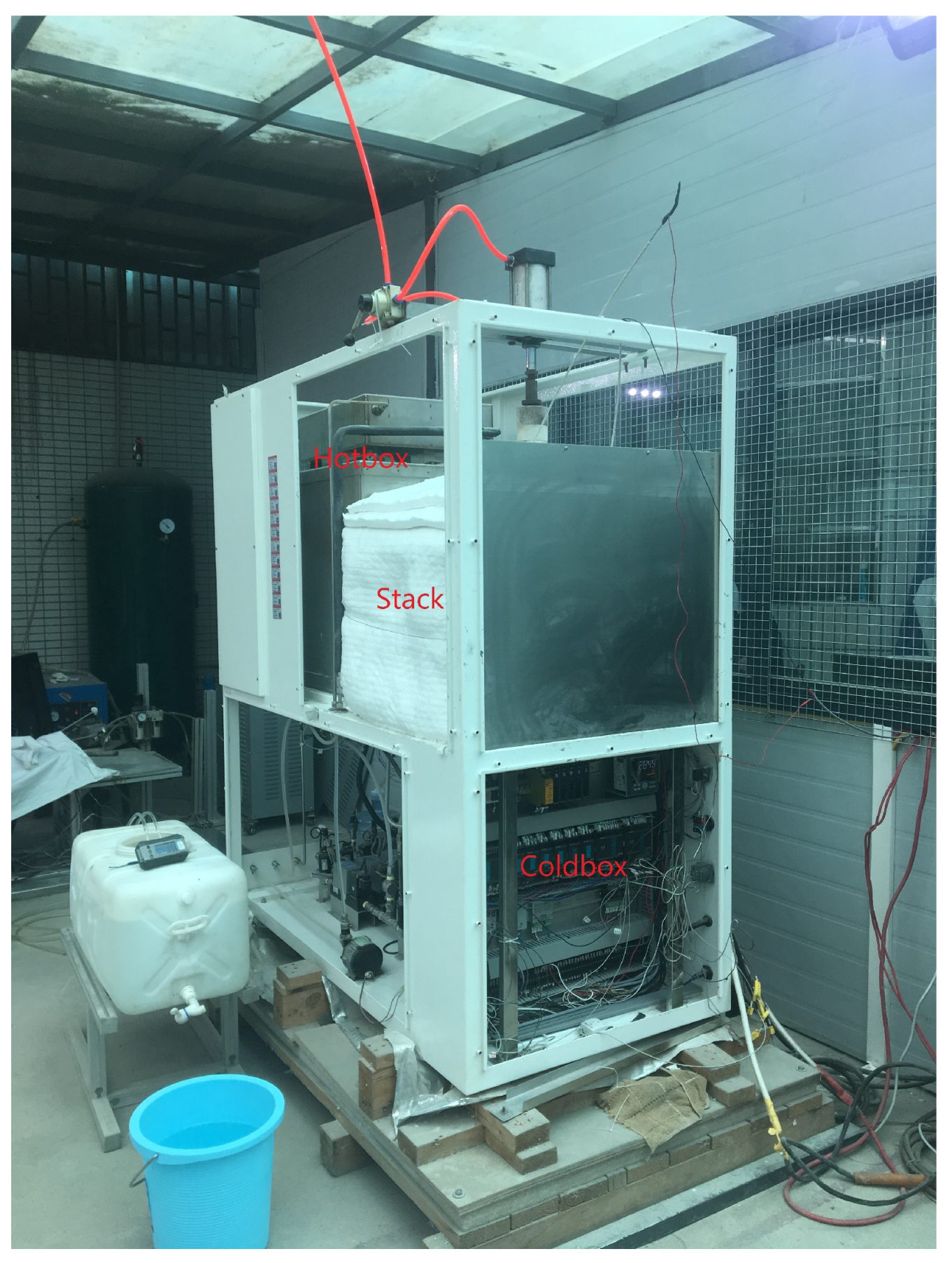
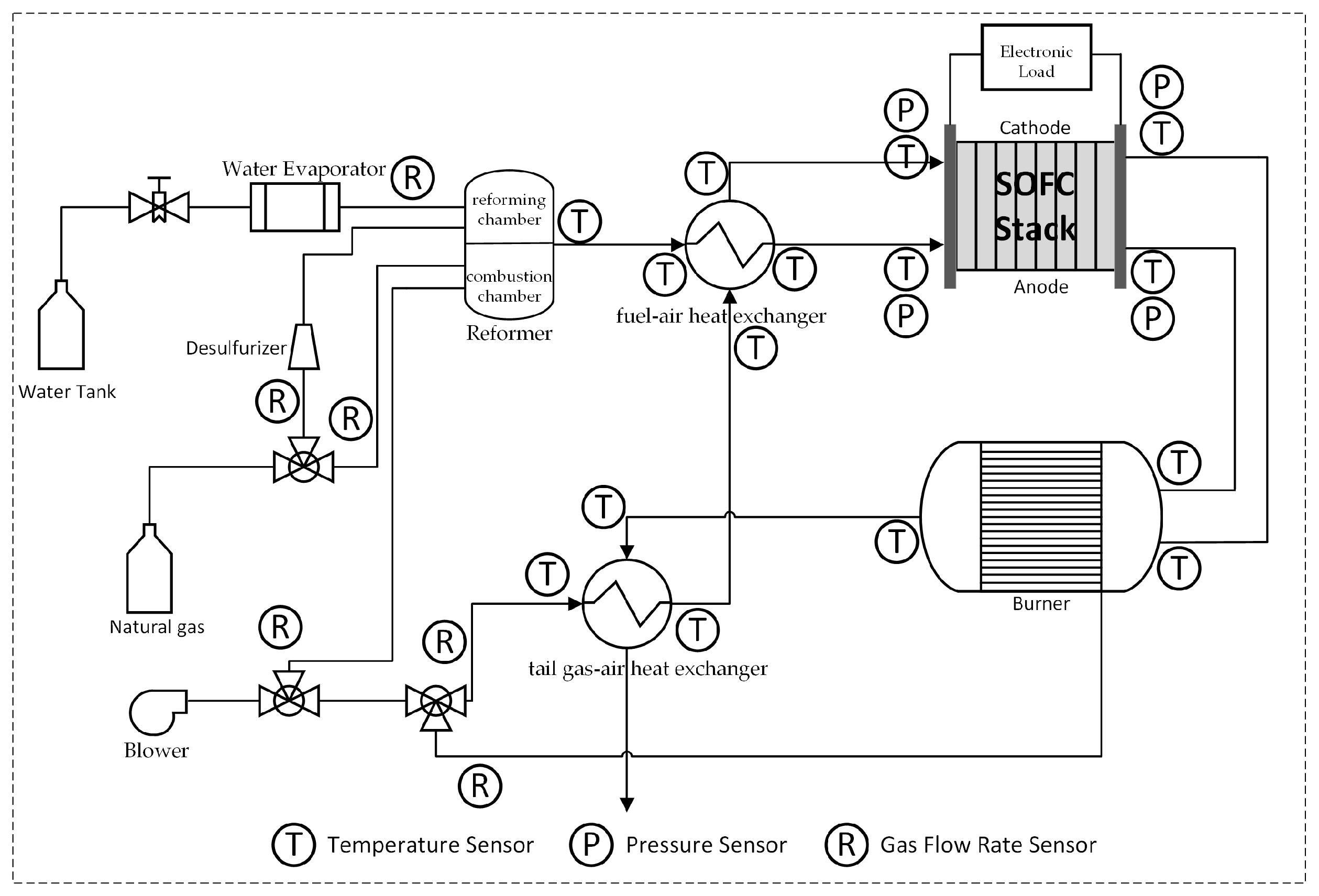
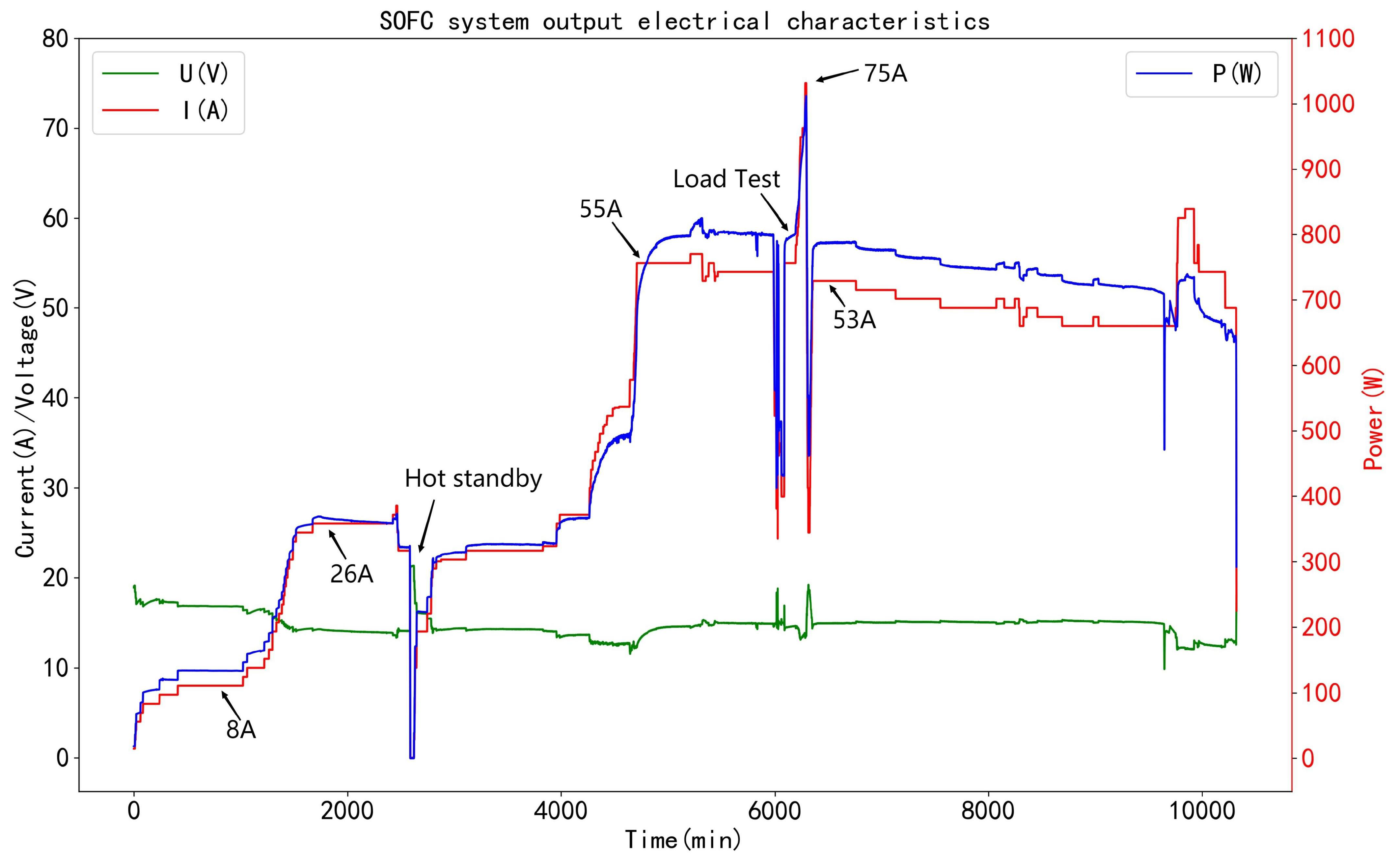
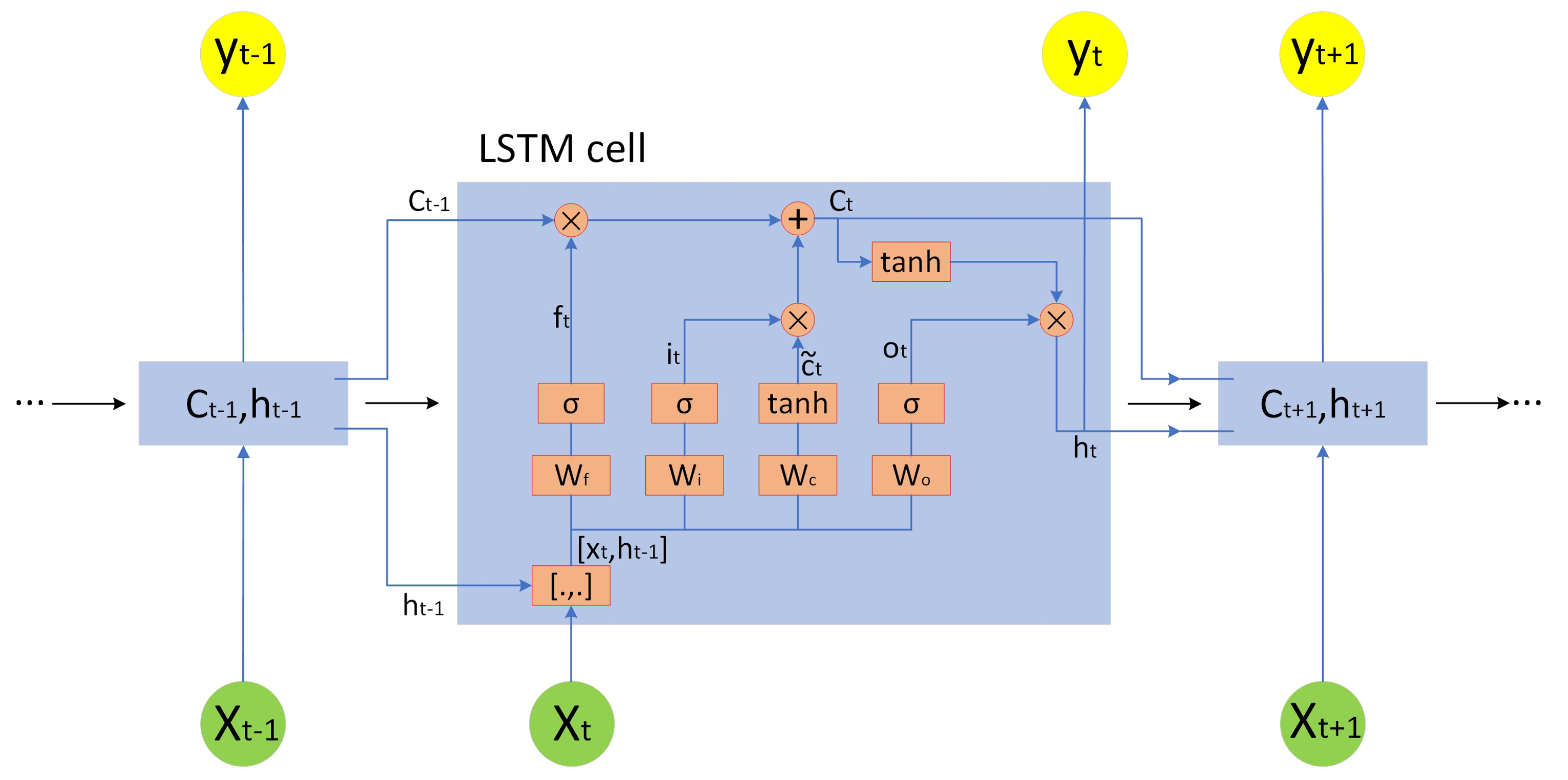

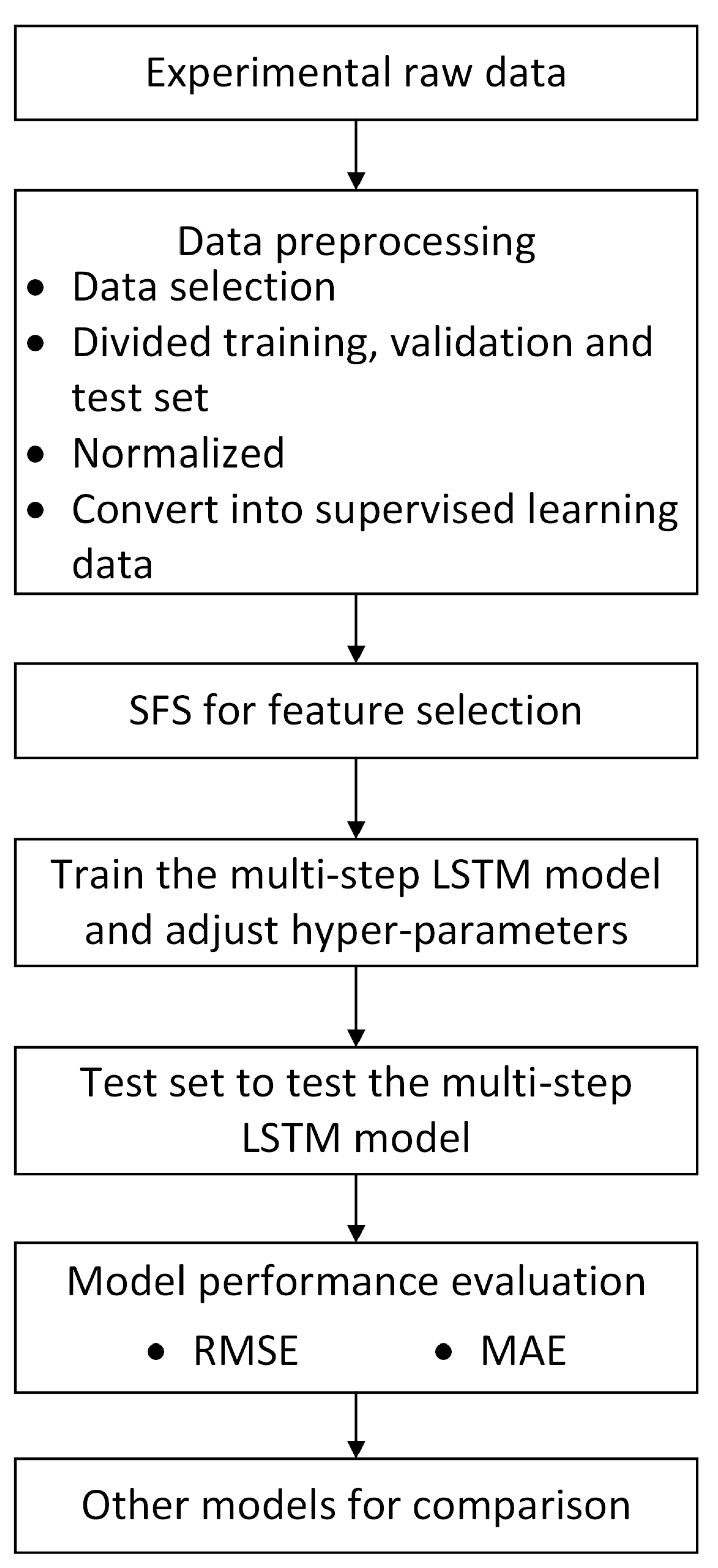
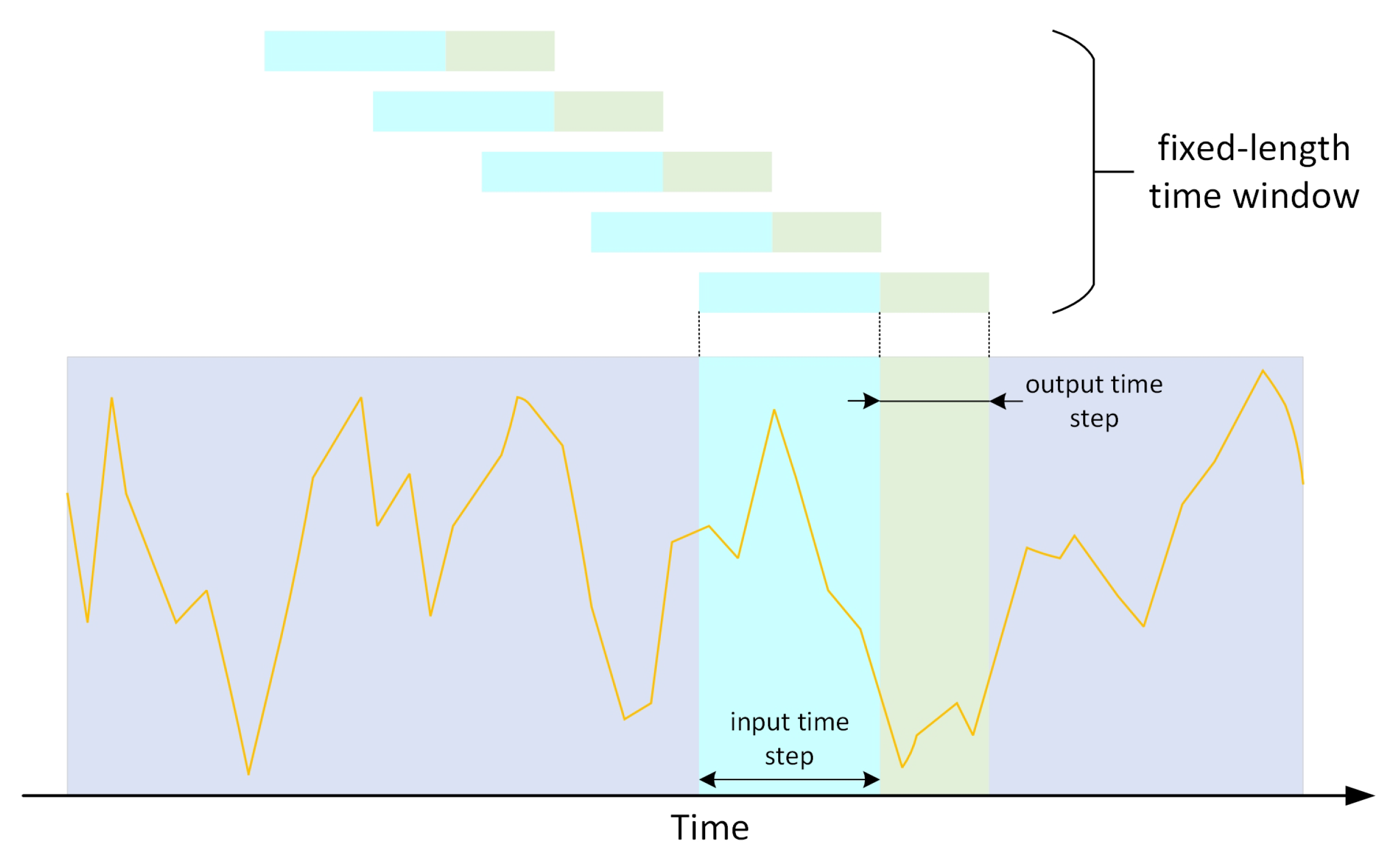
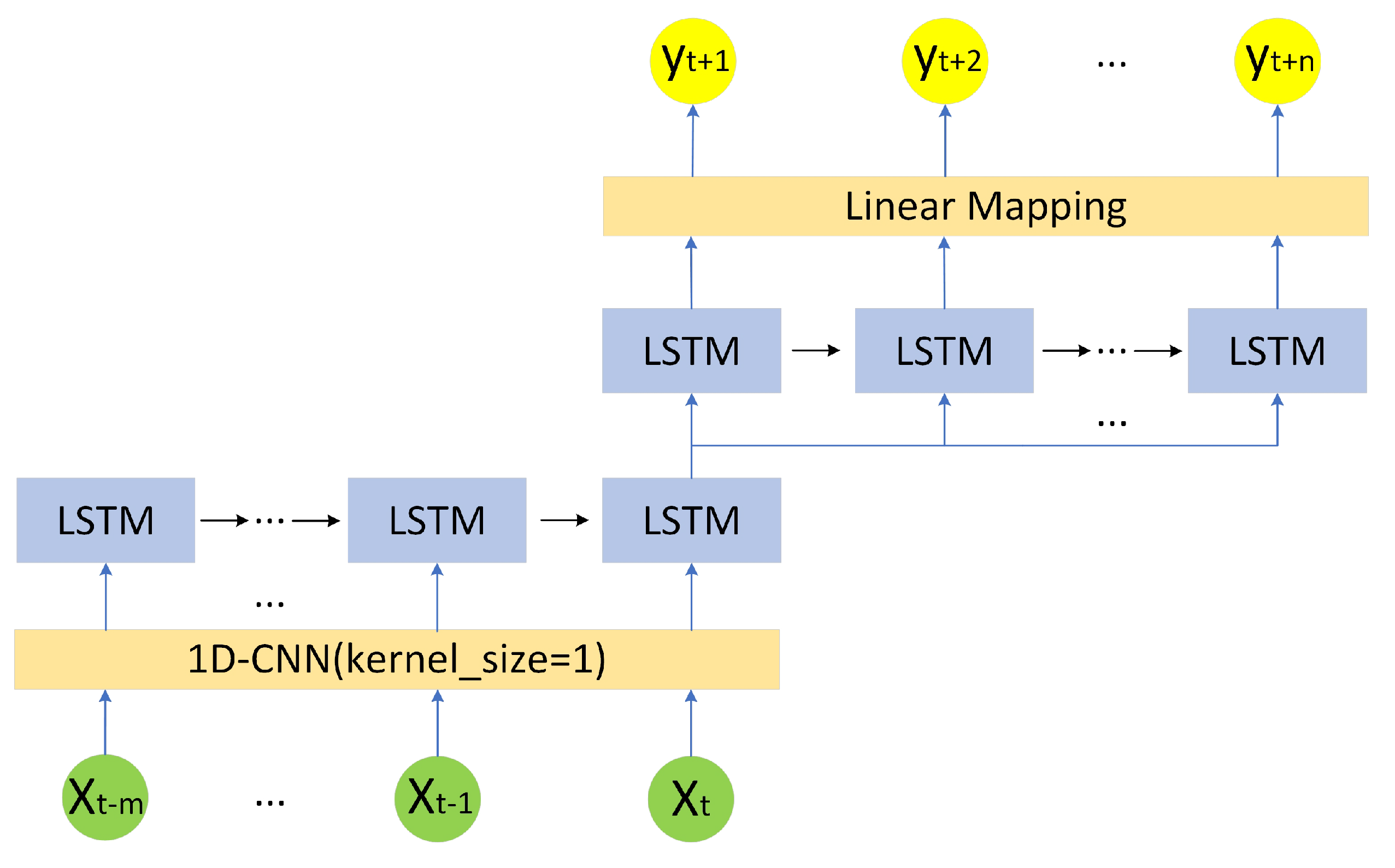
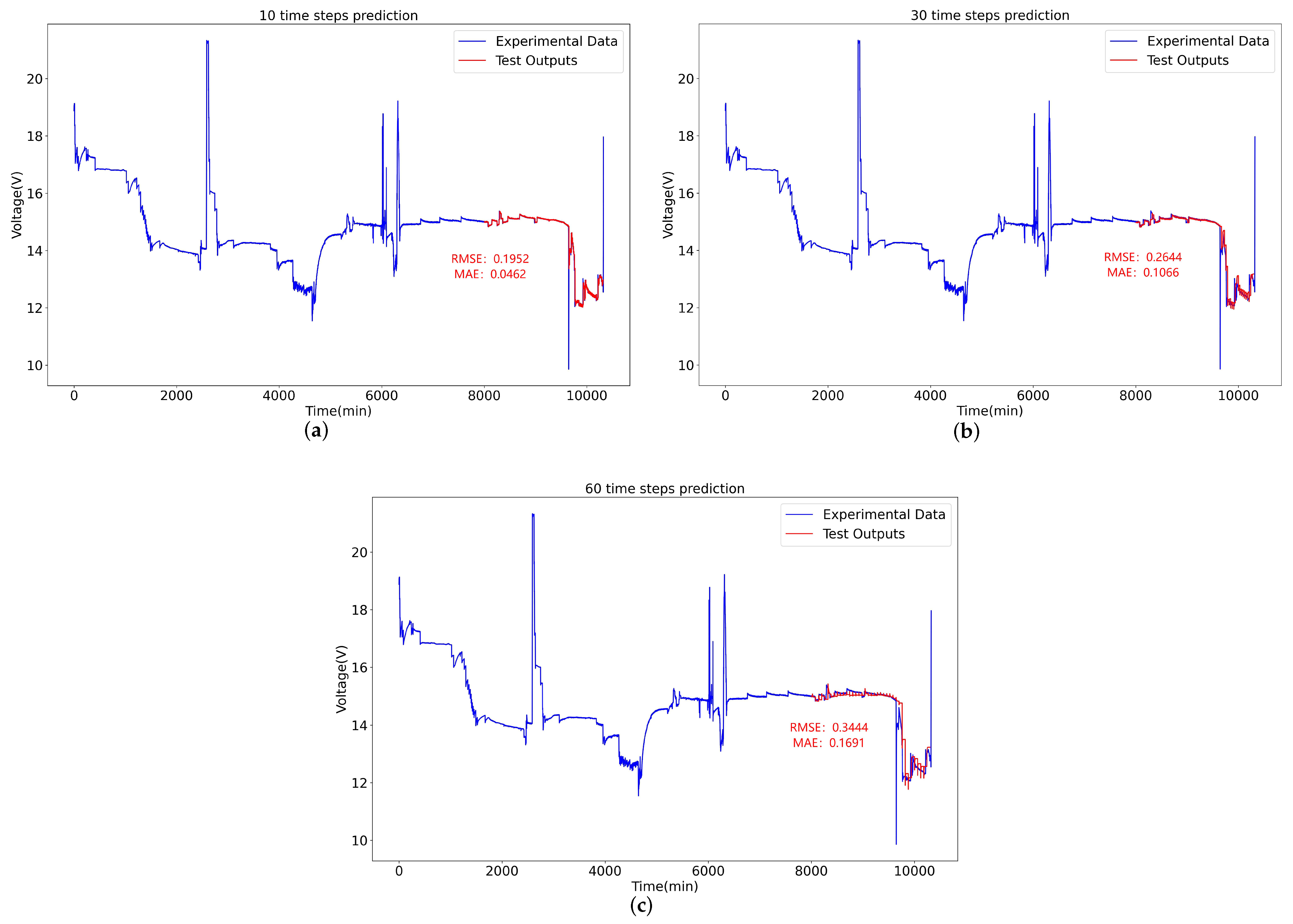
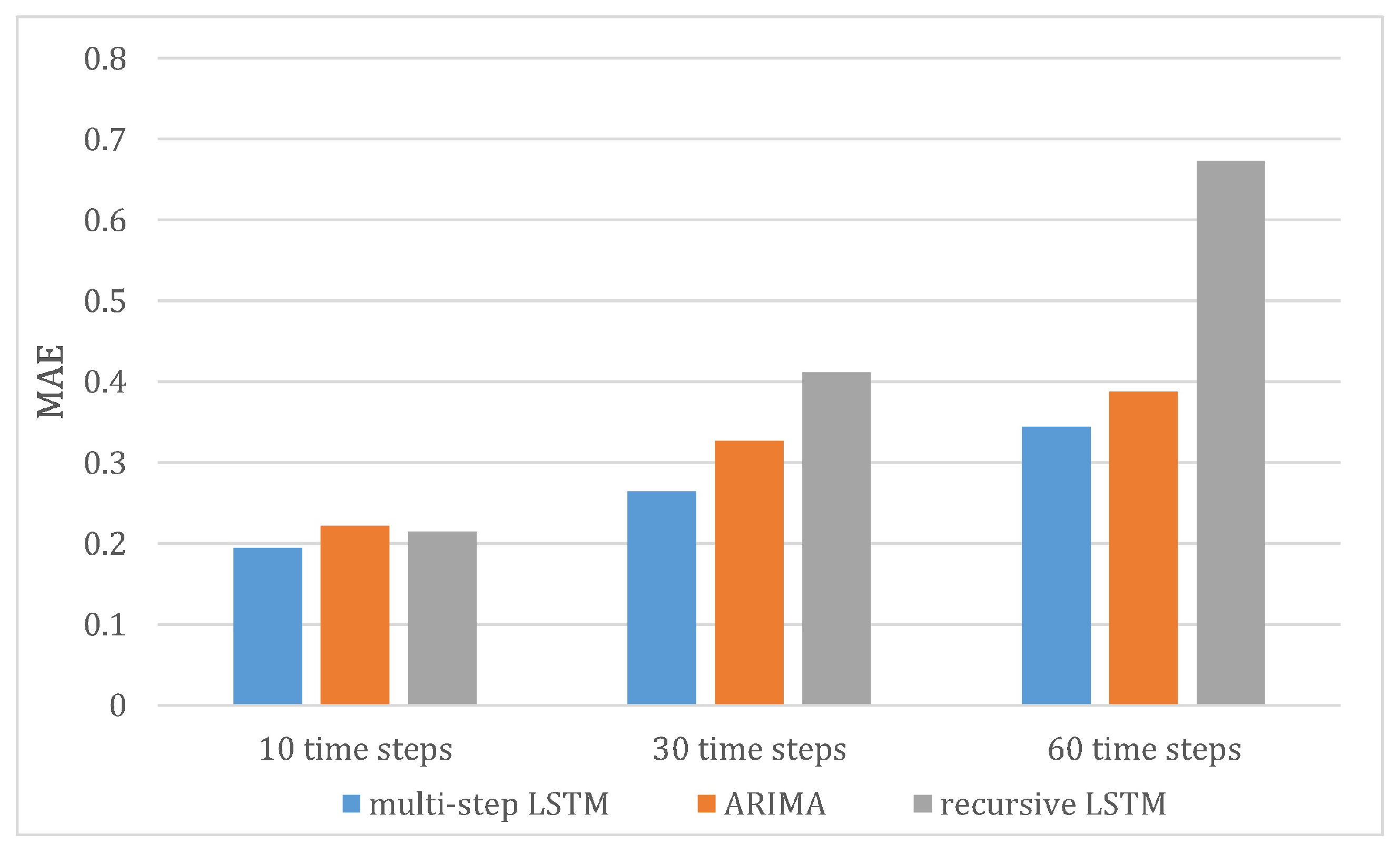
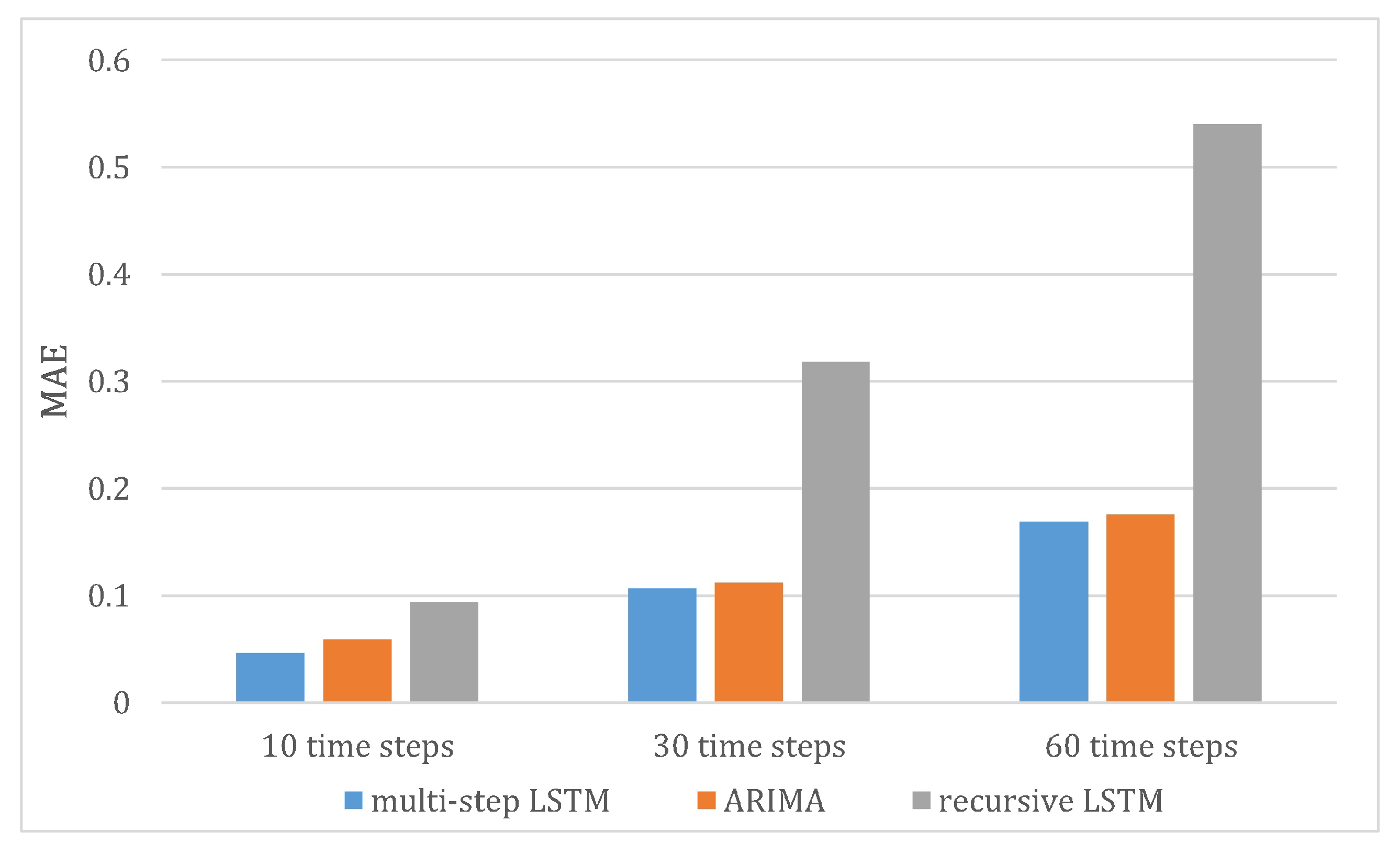
| Variables | ||
|---|---|---|
| Output voltage | Output current | Cathode air flow rate |
| Bypass air flow rate | Methane flow rate | Input methane pressure |
| Cathode air pressure | Bypass air pressure | Anode input pressure |
| Cathode input pressure | Anode output pressure | Cathode output pressure |
| Reformer temperature | Anode inlet temperature | Cathode inlet temperature |
| Anode outlet temperature | Cathode outlet temperature | Fuel inlet temperature of burner |
| Air inlet temperature of burner | Burner temperature | Fuel-air heat exchanger temperature |
| Batch Size | Learning Rate | RMSE | MAE |
|---|---|---|---|
| 10 | 0.001 | 0.0290 | 0.0233 |
| 0.0001 | 0.0239 | 0.0136 | |
| 0.00001 | 0.0307 | 0.0223 |
| Learning Rate | Batch Size | RMSE | MAE |
|---|---|---|---|
| 0.0001 | 30 | 0.0314 | 0.0224 |
| 20 | 0.0240 | 0.0156 | |
| 10 | 0.0239 | 0.0136 | |
| 5 | 0.0226 | 0.0134 |
| Model | 10 Time Steps | 30 Time Steps | 60 Time Steps | |||
|---|---|---|---|---|---|---|
| RMSE | MAE | RMSE | MAE | RMSE | MAE | |
| multi-step LSTM | 0.1952 | 0.0462 | 0.2644 | 0.1066 | 0.3444 | 0.1691 |
| ARIMA | 0.2222 | 0.0588 | 0.3272 | 0.1121 | 0.3877 | 0.1756 |
| recursive LSTM | 0.2144 | 0.0941 | 0.4117 | 0.3181 | 0.6731 | 0.5403 |
Publisher’s Note: MDPI stays neutral with regard to jurisdictional claims in published maps and institutional affiliations. |
© 2022 by the authors. Licensee MDPI, Basel, Switzerland. This article is an open access article distributed under the terms and conditions of the Creative Commons Attribution (CC BY) license (https://creativecommons.org/licenses/by/4.0/).
Share and Cite
Rao, M.; Wang, L.; Chen, C.; Xiong, K.; Li, M.; Chen, Z.; Dong, J.; Xu, J.; Li, X. Data-Driven State Prediction and Analysis of SOFC System Based on Deep Learning Method. Energies 2022, 15, 3099. https://doi.org/10.3390/en15093099
Rao M, Wang L, Chen C, Xiong K, Li M, Chen Z, Dong J, Xu J, Li X. Data-Driven State Prediction and Analysis of SOFC System Based on Deep Learning Method. Energies. 2022; 15(9):3099. https://doi.org/10.3390/en15093099
Chicago/Turabian StyleRao, Mumin, Li Wang, Chuangting Chen, Kai Xiong, Mingfei Li, Zhengpeng Chen, Jiangbo Dong, Junli Xu, and Xi Li. 2022. "Data-Driven State Prediction and Analysis of SOFC System Based on Deep Learning Method" Energies 15, no. 9: 3099. https://doi.org/10.3390/en15093099
APA StyleRao, M., Wang, L., Chen, C., Xiong, K., Li, M., Chen, Z., Dong, J., Xu, J., & Li, X. (2022). Data-Driven State Prediction and Analysis of SOFC System Based on Deep Learning Method. Energies, 15(9), 3099. https://doi.org/10.3390/en15093099







